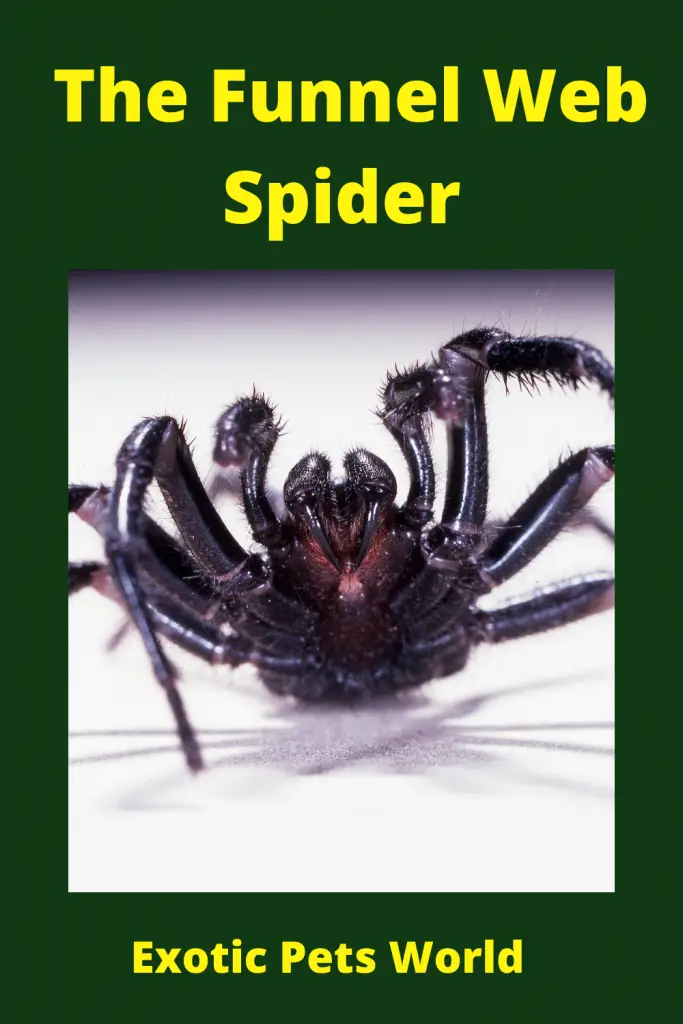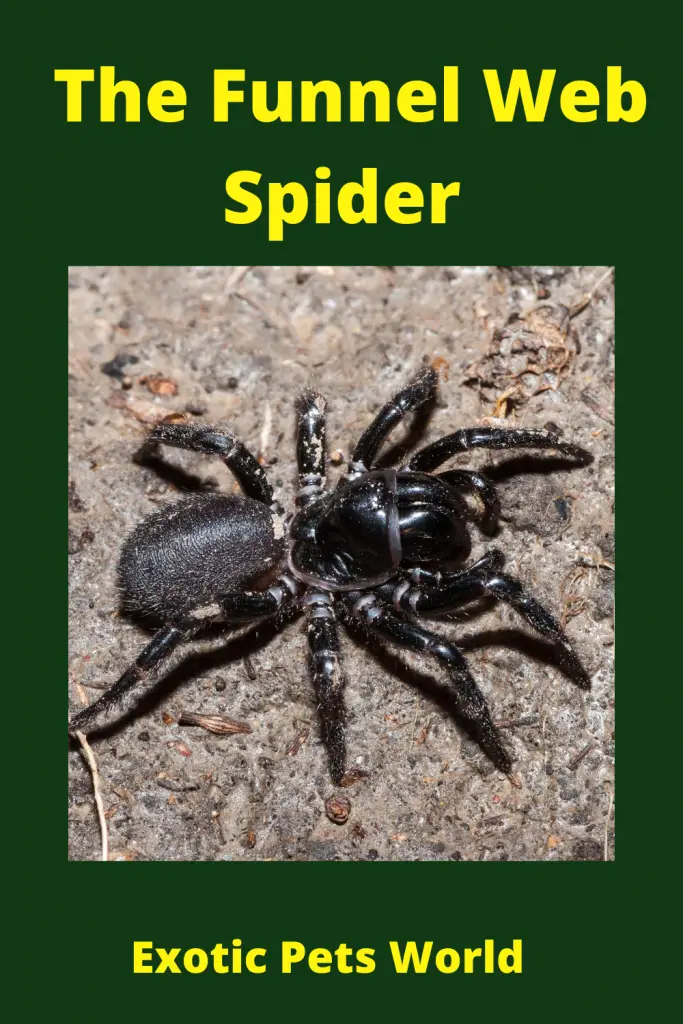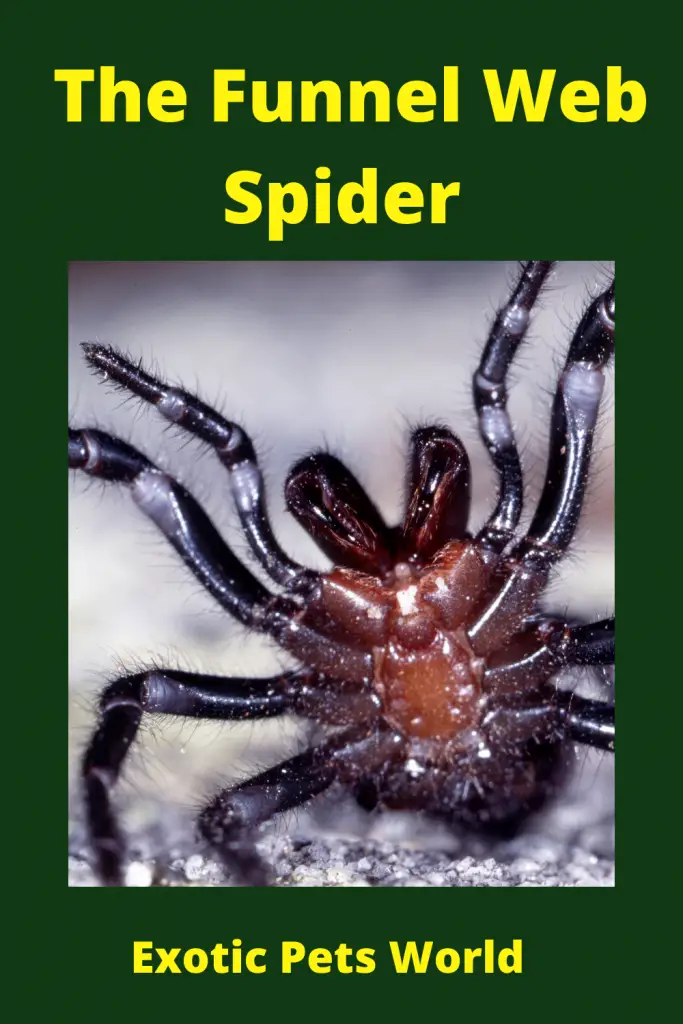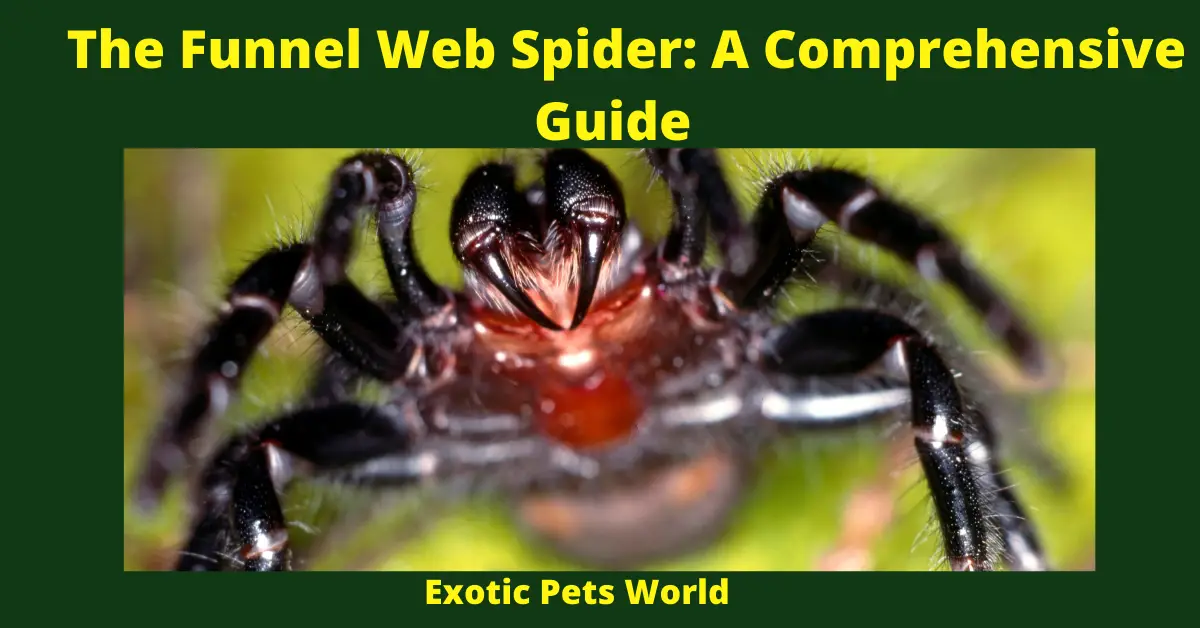12 Funnel Web Spiders Facts
The Sydney funnel-web spider is a type of arachnid that lives in the eastern and southern areas of Australia. There are many species, but they generally range from 1-4 inches long (3 to 10 centimeters). This blog post will cover funnel webs and their life cycle.
Funnel Web Spiders Facts
- Funnel Weavers are either nocturnal or diurnal, depending on the species.
- Funnel web spiders usually have a life expectancy of about two years.
- funnel-web spider bites can be fatal to humans , Funnel Web Bite if received need to go imediately to hospital for anti-venom shot
- The spiders are poisonous and can be found in dark, moist areas such as under logs or rocks.
- There are many types of funnel-web species, but the most common ones live near rivers and streams with lots of humidity.
- The Weaver spider’s diet usually consists mainly of insects, but funnel-web spiders have been known to eat small animals as well.
- These Spiders are usually solitary creatures that spend time in their burrows or webs during the daytime and come out at night.
- This spider’s eyesight is not very good and they rely mainly on vibrations from prey or potential threats around them for sensing their surroundings.
- Funnel spiders have a funnel-shaped opening at the end of their burrow that leads to where they live and can be as long as three feet (one meter) underground, connected by winding tunnels.
- Funnel webs usually build their webs in moist, sheltered areas like under logs or rocks near rivers or streams due to their funnel shape.
- Funnel webs will usually hide in their burrows or build a new web when they feel threatened.
- Funnel spiders have sensitive hairs on their legs and mouthparts that help them sense vibrations from the prey, potential threats, other funnel webs nearby, and the airflow around them to determine where to go next.
Can you Keep Sydney Funnel Web Spider as Pets?
SYDNEY funnel-web spiders are pets that often are pets for experienced spider enthusiasts. They usually don’t need to be fed, and they’re fairly calm compared to other types of spiders. Because of their poisonous potential great care should be taken.
Funnel Web Spider Habitat Care
- Funnel web typically live in dark, moist areas such as under rocks or logs near rivers and streams, so it’s important to provide them with a habitat that mimics this environment.
- Funnel web spiders will sometimes live in houses if they have access to dark areas under furniture or around the home that mimic their natural habitats.
- Funnel webs can be found living alone or together depending on the species, but building a large funnel-web spider habitat can help funnel webs to feel more comfortable living together.
- Funnel webs will need access to food, water, and shelter in captivity.
- Funnel weavers should be housed alone if they get too aggressive with their siblings or other pets that are kept near them.
- Funnel web spiders usually stay in their burrows during the day, so funnel-web spiders should have a nice dark place to hide during the daytime.
- Funnel weaver usually don’t like being handled and will get aggressive when they feel threatened or are exposed too much to light. Provide them with plenty of hiding spots in their habitat for this reason.
- Their name reflects the typ of web and hunting that they do.

What Do Funnel Web Spiders Eat?
They will eat insects, small animals, and other invertebrates.
These spiders typically prefer living near rivers and streams because the humidity from these areas helps them hunt for prey more effectively.
Funnel weaver spiders are very sensitive to the movement of air around them and will react by jumping if it senses a threat nearby, so make sure to keep funnel webs in an area with plenty of ventilation.
Funnel-web spider habitats should be kept dark at all times because funnel webs are very sensitive to light.
Funnel-web spiders can be found anywhere in the world, but they don’t have a preferred environment and will do fine living near water sources or dry areas as long as their habitat is dark at all times.
Funnel Web Spider Captive Care?
Funnel webs/weavers can be found anywhere in the world, but they don’t have a preferred environment and will do fine living near water sources or dry areas as long as their habitat is dark at all times.
Funnel-web spiders are usually calm when you handle them if they’re not too exposed to light during handling. If you have one of the poisonous types – handle it with care.
These Spiders should be handled as little as possible and should be left in their habitat to hunt for food.
Funnel weavers are typically very gentle when they walk on you, so it’s important not to touch them if they’re hunting or walking around because funnel-web spiders rely heavily on vibrations from prey and potential threats that can be affected by your actions.
These Spiders are typically very calm pets, but they should be provided with a dark area to hide if you’re handling them or exposed to too much light during the daytime.
These spiders can get aggressive and will bite if threatened, so make sure not to handle funnel webs without wearing gloves unless the spider is in its habitat.
For Mating spiders should be introduced to each other’s company slowly, so they can get used to being around one another without feeling too threatened.
Funnel Weavers live mostly near water sources because it provides them with prey as well as humidity for hunting purposes.
Are Sydney Funnel Web Spiders in the United States?
Sydney Funnel-web spiders are not in the United States unless in captivity
Sydney funnel webs live on coastal New South Wales and Queensland, Australia.

Can a funnel web spider kill a dog?
Yes, funnel weaver spiders can kill a dog, their venom is very potent.
There are about 20 different species of funnel-web spider that have been confirmed killing dogs and other animals in Australia. These include the Sydney funnel weaver, Hadronyche infensa (this one is only found on Kangaroo Island), Heteropoda venatoria, Ischnothele lumenaria, Ischnotheles crassipalpis, and Spilathene fenestralis
Will Funnel Webs chase you?
Funnel-web spiders are not known to chase humans. It may seem that way but there will try to escape and can be quite quick.
Funnel webs will only chase you if disturbed (e.g., by someone stepping on a funnel-web they are lying in) Trying to rear up and protect themselves. When a spider is rearing back it is an indication that it will defend itself.
These Spiders live mainly under rocks and logs or within the leaf litter of wooded areas near water where there is good air circulation to prevent them from drying out. They also live in manmade structures such as sheds, garages, and houses if an area has not been maintained.
What is the Anatomy is a funnel-web spider?
In general, funnel-web spiders have ahead with two pairs of eyes and eight simple hairy legs. Their abdomen is usually reddish or orange in color and without hair. Females can be up to 90 mm long while males are shorter at around 60 mm
How Fast are Funnel-web spiders?
Funnel weaver spiders move at a speed of up to 25 feet per hour, they are fast for spider standards.
How high can Funnel-web spiders Jump?
It is not common but funnel-web spiders can leap (12 inches) 30 centimeters in height or more when attacking prey. It only takes about 0.13 seconds for the funnel webs’jaws to reach their prey.
What do Funnel-weaver Spiders Eat?
They feed mostly on insects, however, they are also known to occasionally attack small vertebrates such as frogs and lizards. It takes a funnel-web spider an average of six minutes for it to paralyze its victim through venom.
Lifespan: How long can Funnel-Web Spiders Live?
These spiders can live between 18 months to two years. Males usually die after mating because of a lack of nutrition, however, eggs are laid by the female funnel-web before he dies so he has fulfilled his purpose. They can live somewhat longer in captivity
What is Funnel Webs’ Venom like?
funnel webs have no teeth and instead rely on powerful neurotoxins that are injected into their prey through the funnel-web spider’s fangs. These neurotoxins cause paralysis, it is believed to be one of the most toxic venoms in the world.
Sydney Funnel webs vary by species as some have stronger bites than others but all funnel-web spiders can kill a human with an average bite if bitten because of the toxicity of their venom.
What do funnel Webs live in?
funnel-web spiders are burrowers and usually prefer to build their funnel-shaped webs within a tube. These tubes ( horizontal web can be up to three feet deep with an entrance hole at the bottom that is only about one inch in diameter. The funnel-web spider will wait for its prey while holding on from inside this tube, it is a funnel web’s instinct to always stay inside the tube.
Australia funnel weavers can survive in a variety of habitats, they are found all over Australia and live within bushes, logs, or even amongst human dwellings if they have access to living insects.

How do Funnel Webs Reproduce?
Funnel webs usually mate during August and September with males competing for females by engaging in elaborate courtship rituals. Males will first identify a female funnel-web and then try to attract her attention with enticement such as waving their front pairs of legs or plucking strands from plants that they offer to the female funnel-web
Mating is violent because males compete aggressively against each other, but it takes only seconds for the male funnel-web to insert his pedipalps into the female funnel web’s genital opening. The male funnel webs sperm is stored for a period of time in seminal vesicles before being fertilized
After mating, females will lay up to 200 eggs inside their burrows and incubate them until they hatch around 18 months later or sometimes two years
Funnel weaver spider females will sometimes cannibalize their eggs while they are still in the egg sac. This is because a female funnel-web does not have enough food to feed all of her hatchlings and she wants them to be as strong as possible before leaving the burrow.
How do Australia Funnel Webs Defend themselves?
Spiders can defend themselves by releasing a sticky funnel web that captures an insect and pulls it up into the funnel-web spider’s burrow. The funnel webs will then seal off this opening with silk, trapping their prey for later consumption. If Threatened they will rear back on hind legs and show their fangs, if further provoked will bite.
How Many Types of Funnel Web Spiders are there?
There are over 100 types of funnel-web spiders, which is why there’s so much variation in appearance. All funnel-web spiders belong to the family Agelenidae and because they’re all related it can be difficult to identify a particular species by just looking at them. Spiders’ anatomy does vary from one another but some common features that are shared by funnel-web spiders are:
they all have eight eyes, which are always in pairs and arranged somewhat symmetrically on the front part of their bodies. Funnel webs also have six long spinnerets that produce silk at the end of their abdomens.
funnel web’s fangs can be as much as half an inch long and deliver a powerful neurotoxin that can induce paralysis in humans
funnel webs are always borrowers often, they make funnel-shaped webs within a tube with an entrance hole at the bottom. Some funnel-web spiders prefer to inhabit bushes or logs but all funnel-web species will build their webs near living insects so that it’s easier for them to catch prey
– funnel web spiders prefer southeast Australia. They live within bushes if they have access or log piles as well as dwellings if there are living insects for them to consume.
How much venom do funnel webs inject?
Their spider venom is a powerful neurotoxin that can induce paralysis in humans and funnel webs inject enough venom to kill an adult human within 15 minutes.
These spiders are not aggressive creatures, they will usually only Bite if threatened or provoked
Australian Funnel web Spiders Anti Venom
Funnel-web spiders are probably the most well-known, and frankly terrifying of all funnel webs. For a long time they were considered to be among the deadliest creatures in Australia, but thankfully we now have an anti-venom that can save lives if applied quickly enough after being bitten by one of these fearsome critters.
The funnel-web spider is a large funnel-shaped spider that inhabits many parts of Australia, with the exception of Tasmania. The female funnel web can grow up to ( 5 inches ) 12 centimeters in length and have an equally impressive leg span; males are usually much smaller at around ( 3 Inches ) six centimeters long.
They typically live inside burrows that they excavate themselves and they are known to be aggressive, with a bite that can cause serious harm. They wait for their prey out of sight at the funnel’s apex and then pounce when an insect wanders near.

The venom which funnel-web spiders produce is highly toxic but thankfully we have created anti-venom since the 1960s so bites from these spiders are no longer fatal.
Funnel-web spiders have a funnel-shaped snout which is useful for hunting and sucking up insects, it’s also what gives them their name because they like to hang around the funnel of these sorts of shapes. They’re known as one of the most dangerous species in Australia but thankfully we now have an anti-venom to save lives.
Do wolf spiders ( funnel web tarantulas) build funnel webs?
-The funnel-web spiders, the most famous of which is probably the Sydney funnel spider (Atrax robustus), are a group of large and fast-acting mygalomorph spiders noted for their ability to administer highly toxic venom.
However, some wolf spiders can also build funnel webs though they are not well known because, unlike other funnel-web spiders, they do not have a painful bite and are thus less likely to be noticed.
The funnel webs of wolf spider species such as the giant funnel-web tarantula (Malmignata) can sometimes reach one meter in diameter ( 40 inches ) and will often feature a narrow entrance supported by two long trip lines which signal potential prey to stop before entering.
The funnel-web spiders, the most famous of which is probably the Sydney funnel spider (Atrax robustus), are a group of large and fast-acting mygalomorph spiders noted for their ability to administer highly toxic venom. However, some wolf spiders can also build funnel webs though they are not well known because, unlike other funnel-web spiders, they do not have a painful bite and are thus less likely to be noticed.
–
Can you Survive a funnel-web spider bite?
Yes but seek medical attention immediately, since the development of anti-toxin deaths has been rare.
What is the Lifespan of a Funnel-web Spider?
The funnel-web spider lifespan is often in the range of one to two years. The funnel-web spider will only live for a few months as an adult and usually lives up to three or four weeks after hatching from the egg sac The funnel-web spider lifespan can be longer if they live in captivity and do not have to fight for food.
What are the Benefits of Funnel Web Spiders?
The funnel-web spider is one of the many spiders that are venomous and can have a painful bite but there are benefits to funnel webs. They prey on insects in their natural habitat which makes them helpful for reducing agricultural pests. The funnel web also has an important role in controlling populations of other organisms like flies, mosquitoes, ticks, and wasps.
What are Natural Predators of Funnel Web Spiders?
The funnel-web spider has a number of natural predators including frogs, lizards, and other spiders. There are also some animals that funnel webs prey on such as the grasshopper since it makes up about one-third of its diet. When caught in their burrow these funnel-web spiders will often defend themselves by biting but there are many funnel-web predators that will kill them in their own home.
In the general funnel, webs are not aggressive and they prefer to retreat into a small crevice or hole if they feel threatened by anything. They will bite when provoked although funnel webs have yet to ever actually kill a human being.
How to prevent Funnel-web spiders from entering your house
There are a number of funnel-web spiders that can be found in the Sydney area and one way to prevent them from entering your house is by using screens on windows and doors. There are also funnel-web spider repellents available. .
Final Thoughts
Thanks for reading this article on funnel webs! Check back soon to read more about spiders and other unique creatures that live around us every day.

Your point of view caught my eye and was very interesting. Thanks. I have a question for you.